Lichen Dyes
Sometimes good things come to those who wait.
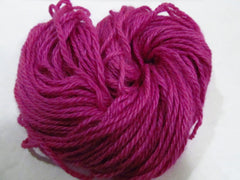
Last spring the Pacific Northwest suffered some severe ice storms that brought down big trees and lots of branches. This caused problems for many people, but there was an upside for me. With the downed branches came menageries of dye lichens, some of which are not easy to come by – especially in such abundance.
When lichens that normally thrive in tree tops are relinquished to the forest floor they will lie there with the branches and be consumed by the natural forces of decay. I try to limit my lichen collecting to the wind-fallen or excessively abundant types.
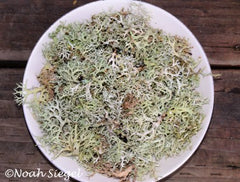
Over the course of spring, every time I went out to harvest nettles or cottonwood buds, I would bring a little bag and fill it with Evernia prunastri, the Staghorn Lichen. Once home, I’d lay my collection out to air dry and store it for later. Evernia prunastri is sage colored lichen that if left to soak in a mixture of water and ammonia, will slowly develop into a beautiful electric lilac dye. Purple mushroom dyes are rare in the PNW, so this is a welcome addition to the dyers pallet. Technically lichens are weird fungi that require a dependent relationship with certain algae for survival; but that is another story entirely.
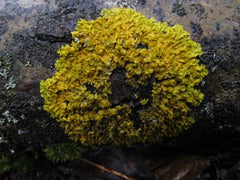
Late March of last year, while checking my Verpa bohemica patch, I found huge, old cottonwood trees crisscrossing this usually open creek side forest. Many of the fallen tree tops were decorated with the striking and elusive Xanthoria lichen. In the tree tops, this lichen grows pressed flat against the bark in 2-5inch circles of golden-chartreuse with tiny speckles of lime green discs that are the reproductive structures of the organism. It is often seen much smaller on tombstones and boulders in arid conditions; places where it is best left for the enhancement of the landscape. But here in the humidity of the little river valley it had grown large and abundantly, now littering the wetland where it would soon deteriorate to a patch of slime on the bark. The misty conditions that day made the lichen pliable and slightly less tedious to harvest, but even after a couple of hours I had only collected about a quarter cup.
Xanthoria also requires an extended soak in diluted ammonia to activate the color potential. So one day last April, I made up the lichen ammonia mixes. Though they immediately turned bright colors, I knew the colors I was after would take time to develop. The first few weeks I shook the jars daily, but after a while I neglected them. When I remembered, I checked in them again and after a couple of months the Xanthoria solution was a juicy red and the Evernia a deep burgundy. I had read that ammonia lichen dyes needed to be exposed to oxygen to develop their maximum purple potential, so I set it out over night with the lid removed, and in the morning put the lid back on and shook it some more. Within a few days it transformed to the color of purple kool-aid.
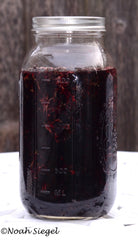
I was very excited to try it out, but I was moving – so into a box it went, and was carried by car all the way from Seattle to Massachusetts. Once unpacked, I’d shake it occasionally and open it for a few hours every once in a while; the colors deepened.
While in Massachusetts I was introduced to Umbilicaria, affectionately known as Rock Tripe – another ammonia activated dye lichen. I was given a couple of jars full, that I processed in the same way as the others. Essentially in the same pattern of attention and neglect. Almost a year later, and another cross-country trip, I decided to finally dye with the ammonia dyes. They looked to delightful in the jars; red juice, grape kool-aid and blackberry wine.

In a double boiler I heated up the ammonia lichen mixtures, adding water to allow for the wool to move freely in the half-gallon jars. I simmered the pot for an hour, until they were as bright as they were going to get. I let the wool sit in the dyes overnight and rinsed them in the morning.
Straight out of the jars, the dyes were spectacular. The Umbilicaria produced a blinding magenta wool and the Evernia was an amethyst violet.
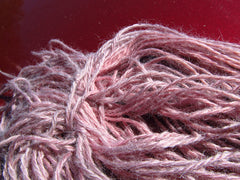

As for the Xanthoria, well that produced a special and strange dye. Once removed from the dye-pot, rinsed and set to dry in the sun, it immediately began to show a cyanotic bluing, as though the life was draining from its powder pink glow. The color first took on subtle lavender tones and eventually completely turned a pale slate blue; its lovely warm pink blush forever gone.
